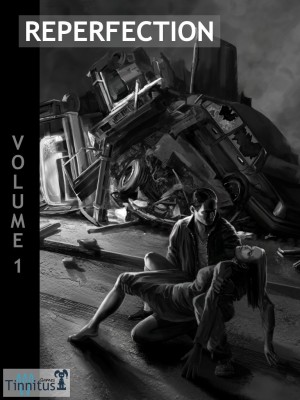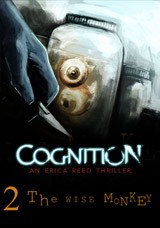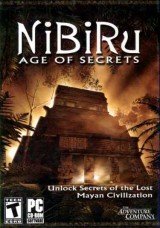Review for The Cave page 2
As the camera descends from a purple, moonlit sky at the beginning of Ron Gilbert’s newest game, The Cave, you might experience a twinge of déjà vu. Seven characters stand at the mouth of an ominous cave, waiting for you to select three of them to explore its depths. This set-up is obviously reminiscent of Maniac Mansion, Gilbert’s first game and the first ever to use the point-and-click, verb-based SCUMM interface that would become LucasArts’ hallmark. But The Cave is very different than the adventure games Gilbert pioneered and, frankly, very different than anything else out there right now. Adventure fans will argue at length about what genre it is, but one thing’s for sure: The Cave is a brave experiment, a mix of old-school thinking and newfangled execution that makes it well worth a visit.
The game opens with no tutorial to demonstrate the controls or cinematic cutscene to introduce how these seven people ended up here. All we get is voice-over narration, courtesy of the cave itself, explaining that each of them is looking for something they deeply desire. (Such omniscient narration continues throughout the game, with the cave serving both as a tour guide to point out its prominent features and as a commentator to weigh in on the characters’ morally questionable choices.) After waiting a minute or so for something to happen, I started messing with the controller and realized that the motionless characters had been waiting for me. The Cave is often like this; the game doesn’t lead you by the hand. In an era when pre-game tutorials, hotspot finders, and hint systems are standard, The Cave’s unapologetic “figure it out yourself” attitude reminds me of the oldest text adventures, Zork and Colossal Cave, and even a bit of Myst—all games that dropped players into a vast, uncharted world with no explanation or guidance and expected us to find our own way.
I played The Cave on PlayStation 3, where the controls involve using the left analog stick to move and the face buttons to jump, pick up and use items, or employ a character’s special ability. Running is the typical method of conveyance, but you can also walk by moving the analog stick more gently, swim in pools of water, and climb up and down ladders and ropes. Each character is assigned to a button on the D-pad that you can press to switch between them, and a legend in the lower left corner of the screen shows which character is tied to which button. The PC version enjoys all of the same functionality but with more options: you can choose to play with the keyboard (map the actions to any key you want), the mouse (standard point-and-click or a click-and-drag method), or both, or you can plug in a controller instead.
The controls may be different than what you find in most adventure games, but they work well here. It’s more active than pointing, clicking, and waiting for the character to walk across a room, yet simple enough that little thought, timing or dexterity is required. Even if you sometimes make a wrong move there’s no real penalty for doing so; it is possible to die, but your character simply poofs into a bright light and instantly respawns nearby, good as new. Sometimes I inadvertently jumped into a pit of spikes or took a few tries to grab a ledge, but these fumbles didn’t trip me up any more than accidentally clicking the wrong hotspot or triggering a conversation I’d already heard in a traditional adventure—the sorts of ‘oopses’ that happen all the time.
On my first playthrough I selected the Twins, the Scientist, and the Time Traveler. The Twins are peaked, Edward Gorey-looking children who travel as a team. Their special ability allows them to slip through lever-operated doors that other characters can’t, and their big desire is to go outside and play. The Scientist, a large-headed lady in a lab coat who’s on the verge of a massive scientific discovery, can activate certain machines that others can’t. And the Time Traveler, a woman with a glowing suit and hoverboard technology in her shoes, needs to right a wrong a million years in the making; her special power involves warping through obstacles to reach the other side. The four other characters are equally quirky, but I’ll leave their secrets for you to discover.
The Cave is much heavier on puzzles than narrative, but it does have something of a storyline relating to the desires that brought these people here, what they’re willing to do to get the thing they want most, and the role this mysterious talking cave plays in it all. There’s no right or wrong combination of characters; the gameplay and overarching story is basically the same no matter who you travel with. During your journey, you’ll encounter cave paintings specific to your trio that gradually reveal their backstories, and each character has access to a unique area of the cave with a personal side plot and puzzles that complement their desire. Although they do relate to the main storyline, the mini-stories are rather basic and essentially interchangeable. It's worth replaying The Cave once or twice to experience all of the character-specific nuances, but you’ll easily get the point of the story with only one playthrough.
The cave has six common areas that you’ll visit regardless of who’s in your party, plus three that are specific to your selections. You’ll encounter these areas at different points in the journey depending on who’s with you, but the experience is linear within any one playthrough; there are no branching paths where you choose to explore one area instead of another. As you descend, the cave is shown from the side with a cutaway view, like an ant farm. It’s one huge environment that you travel through fluidly without having to pause for new areas to load, but you only have access to a small segment of the cave’s large footprint at any time. The 2D perspective should be familiar to point-and-click fans: you can only move up, down, left, and right, and you can only see the area immediately around the active character. Although a free roaming camera would have been helpful at points when you’re trying to reunite your party across a distance, this zoomed-in view succeeds in making the cave feel like a massive place in need of exploring, with no telling what dangers might be lurking just beyond the sight line.
Unfortunately, backtracking is often necessary, both while you’re figuring out an area’s layout and once you realize what you need to do to solve its puzzles. At certain points the two currently passive characters will catch up with the active character automatically, but in general they don’t follow each other around, so you sometimes need to traverse the same area with all three of them, one by one, to get everyone where you need them. Of course, backtracking is fairly common in adventure games that have a large area to be explored, and it’s no worse in The Cave than in many point-and-click classics, but it is nevertheless a recurring annoyance. At the very least, a “recall party” option would have been extremely helpful to reunite your trio, or a “follow me” feature to keep them together.
The environments are always interesting to look at, with a mix of cave-like stuff (stalactites, waterfalls, phosphorescent growths, interesting rock formations, etc.) and stuff you’d never expect to see in a cave. Within each character-specific area, the world the character comes from and the desire they’re trying to satisfy is reproduced. The Twins’ area is a gothic house with lots of staircases and high walls and locked doors, while the Time Traveler’s contains a portal that gives access to the same caverns in three different time periods, and the Scientist’s is a sterile facility on the verge of a nuclear warhead launch. Other notable landmarks include a medieval castle, a sprawling carnival, a desert island, and a Zen monastery atop a towering mountain. It’s frequently dark in the cave, but the artwork is saturated and vivid, with the light in each area taking on a different tint. The characters are also uniquely depicted, with a puppet-like aesthetic that’s a cross between Pixar and Punch & Judy. My only complaint about the graphics is that the fixed camera angle denies us the close-up views that would show off the grottos and vistas in more detail.
The puzzles are logic-based and often make use of inventory items. The Cave has a very simple inventory system: each character can hold one item at a time, which is visible in their arms as they carry it around. Generally you’ll use an item near where you found it, but it is possible to carry items from one area to another and use them for alternate puzzle solutions later on. (This doesn’t happen in reverse; you can’t lose access to something you’ll later need.) The puzzles contained within the characters’ special areas share a nice synergy with the characters themselves—for example, the Time Traveler’s puzzles require manipulating one time period to take advantage of the repercussions in another, while the Monk must solve a series of Zen-like riddles to achieve enlightenment, and the Scientist’s area is full of logic puzzles.
Many of the solutions involve getting characters into position to do something in tandem, such as pulling three levers at the same time to open a gate, pushing a button on an upper level to send an elevator down to another character on the lower level, or pushing a mine car down the tracks so the character riding in it can reach an otherwise inaccessible area. Sharp reflexes are usually not needed, but some solutions rely on a domino effect that requires switching between characters quickly to make each piece of the solution happen in time. In doing so it can be easy to mix up the buttons assigned to the characters, and if you accidentally switch to the wrong one you might miss your window of opportunity. Luckily the cave is forgiving; you always get another try. Puzzle difficulty varies, with a comfortable balance between some simple challenges and others that require more thought, but they’re rarely punishing. In fact, a few times when I repeatedly failed at what I thought was a solution, the uncharacteristic difficulty of my approach tipped me off that I was on the wrong track.
Aside from an audible uh-uh when you try to use an item that can’t be used, the playable characters don’t speak. But each area has a few voiced NPCs and the narrator keeps popping in, so The Cave is far from mute. I had no complaints about the voice acting—the cave has a rolling baritone that’s easy to listen to, and the various other characters (an elderly king, an irate miner, the Twins’ British parents, etc.) speak with voices that fit their roles. Even where dialogue is sparse, music and sound effects pick up the slack to further the ambiance and maintain suspense as the travelers venture deeper into uncharted territory. Each area has a distinct theme that fits with the setting—my favorite was the ominous horn music that plays in the Scientist’s lab, reminiscent of the fanfare you’d expect when a James Bond villain enters the room, but I also found myself humming the Hillbilly’s carnival theme long after I’d turned off my console.
The Cave is designed to work with a single player alternating between all three characters, but it also supports local multiplayer for up to three people, which means one or two other people can control the other characters on the same computer or console. (Gamepads are needed for each extra player on PC.) After having a great experience with this on a preview version, I talked my non-gamer significant other into joining me for my second playthrough. While I still enjoyed the collaborative brainstorming that multiplayer allows for, this time I noticed some logistical idiosyncrasies that didn’t jump out at me initially. With multiple players, the characters are still mapped to buttons on the D-pad, but any player can take over any character at any time. Sometimes this resulted in one of us thinking we were controlling a character, because we were moving the joystick and the character was moving on screen, when in fact the other person was in control. The legend that shows the character button assignment displays a small P1 and P2 to indicate which player is controlling which character, but when you’re concentrating on what’s happening on-screen, the legend is easily overlooked.
Like in the single player mode, the camera always sticks with the active character, so Player 2’s character might remain off-screen for a long time while Player 1 does all the heavy lifting, leading to boredom. (This is especially true in certain areas like the Twins’ house, where the other characters are denied access.) And while there are benefits to solving puzzles with a like-minded player, if the person you’re playing with isn’t really into it or doesn’t have the same ideas you do about what to try next, impatience might kick in. I still think multiplayer is a very cool aspect of The Cave that can work beautifully in the right scenario, and if you’re someone who likes to play games with a partner or friend, the two (or three) of you should definitely give it a try. Just know that if you prefer playing alone, you’re not missing out; exploring The Cave solo is equally rewarding.
There’s been a lot of debate about whether The Cave can truly be an adventure game, with its platformer-like layout and all that moving around the characters can do. We’re so used to the slooooow walking in point-and-click games that aerobic activities like jumping and swimming may seem inherently out of place, but it’s not as if The Cave is the first adventure to have this sort of thing. Nearly all of the early Sierra games included jumping and swimming, too, and many more recent games (Broken Sword, Dreamfall, Heavy Rain, The Walking Dead, etc.) have endeavored to integrate comparable movements into an easily accessible interface. The Cave does this well, translating the physical act of exploring a cave into a physical act for the player, and as a result the game is way more dynamic and exciting than it would have been if presented in the SCUMM style. Like the New Grog that appears in vending machines along its passageways, The Cave’s formula won’t be to everyone’s taste. But if the only thing holding you back is the so-called platforming, I promise there’s nothing fundamentally difficult about the mechanics—even the most casual gamers should be able to deal with them.
The only serious gameplay issue I encountered had nothing to do with running or jumping, but with a rare instance of poor implementation. In one area, an otherwise very clever puzzle requires a very unintuitive use of the controls that had me stuck for so long that I finally had to seek help. (Without spoiling anything, if something totally logical isn’t working like you think it should, try holding down the action button while you switch between characters.) I’ve since learned that this is a common stumbling block, so hopefully Double Fine will address it with a patch. But even during the hour or more I spent stuck on this issue—out of about seven hours total, my first time through—The Cave was a joy to play.
In fact, I loved pretty much everything about it until I reached the end and thought back on the story. That’s when I started to feel let down. It's not that the story’s bad, there’s just not enough of it. (Hey, the thing I desire most in an adventure game is a good story, and just like The Cave’s seven explorers, I’m greedy!) The game has glimmers of Gilbert’s trademark humor, both in its situations and in the voiced lines, but the overall narrative is sparse and regrettably anticlimactic. What starts as three random people on a spelunking adventure does morph into an allegory about greed and human nature along the way, but the narration has a “here we go again” resignation that stays constant throughout. Regardless of how you solve the puzzles or whether you make the small choice near the end that yields a “good” outcome instead of a “bad” one, nothing really changes. I did appreciate the small twist in the final level—despite everything the narrator tells us, the cave isn’t quite what we’ve been led to believe. But I was fairly ambivalent about the epiphany at the end, possibly because I heard it passively via narration rather than figuring it out for myself through gameplay. It just didn’t give me chills like a good ending should.
But even if its narrative falls short, so much of The Cave works well. Ron Gilbert’s most recent game is innovative in many of the same ways as his very first: it gives adventure gamers new ways to interact with the world, a new type of inventory, new methods for puzzle solving. But maybe ‘innovative’ is the wrong word, because all of those things are really just traditional adventure elements stripped down to the basics. The mystique of Myst is here, and the camaraderie of Maniac Mansion, the humor of Monkey Island and the twisty passages of Zork and Colossal Cave—in a sense, Gilbert and the team at Double Fine have condensed 30 years of adventure gaming traditions into this one experience. So if a game like this is the thing you desire most, you should know by now what you need to do. The Cave is waiting.



_capsule_fog__medium.png)


























